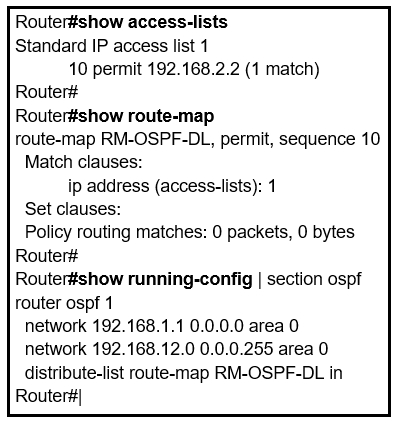Refer to the exhibit. An engineer is trying to block the route to 192.168.2.2 from the routing table by using the configuration that is shown. The route is still present in the routing table as an OSPF route.
Which action blocks the route?

Refer to the exhibit. An engineer is trying to block the route to 192.168.2.2 from the routing table by using the configuration that is shown. The route is still present in the routing table as an OSPF route.
Which action blocks the route?

To block the route to 192.168.2.2, it is necessary to change the sequence 10 in the route-map command from permit to deny. The current configuration permits the route as it matches the specified access list and permits the route map sequence. By changing the sequence to deny, any route matching the access list (in this case, 192.168.2.2) will be denied, effectively blocking it from the routing table.
Agree with B
should be B i think
Tested in lab. Answer A: permit in ACL and permit in route-map - 192.168.2.2 remain in the routing table. Answer B: deny in ACL and permit in route-map will remove 192.168.2.2 from the routing table. Answer C: permit in prefix-list and permit in route-map - 192.168.2.2 remain in the routing table. Answer D: the sequence 10 already let the 192.168.2.2 remain in the routing table.
It is sure, B.
B is it
I choose B
C is the answer because Prefix-list goes with distribution-list not with access-list.
Distribution-list matches a route-map, not an ACL...
I agree with B
agree with B
answer is B
I'm sure it's B
Confirmed now in PNET Lab. Correct (B)
We use a prefix list as it's name implies to match a list of subnets. In this case we only want to deny just one subnet. Now also in the question it does not specify if all other networks need to be denied. I go for B
it´s B
B is correct
I lab it and B is the correct one.
B is correct answer